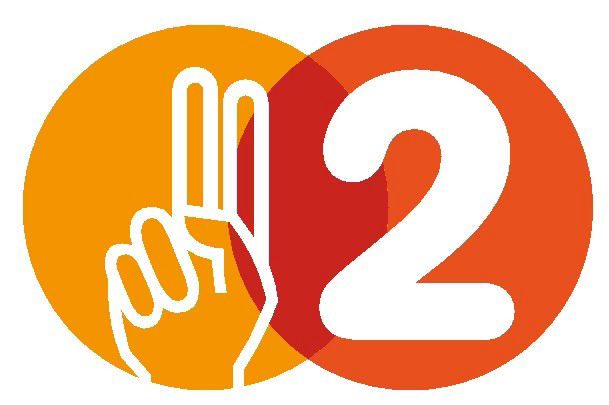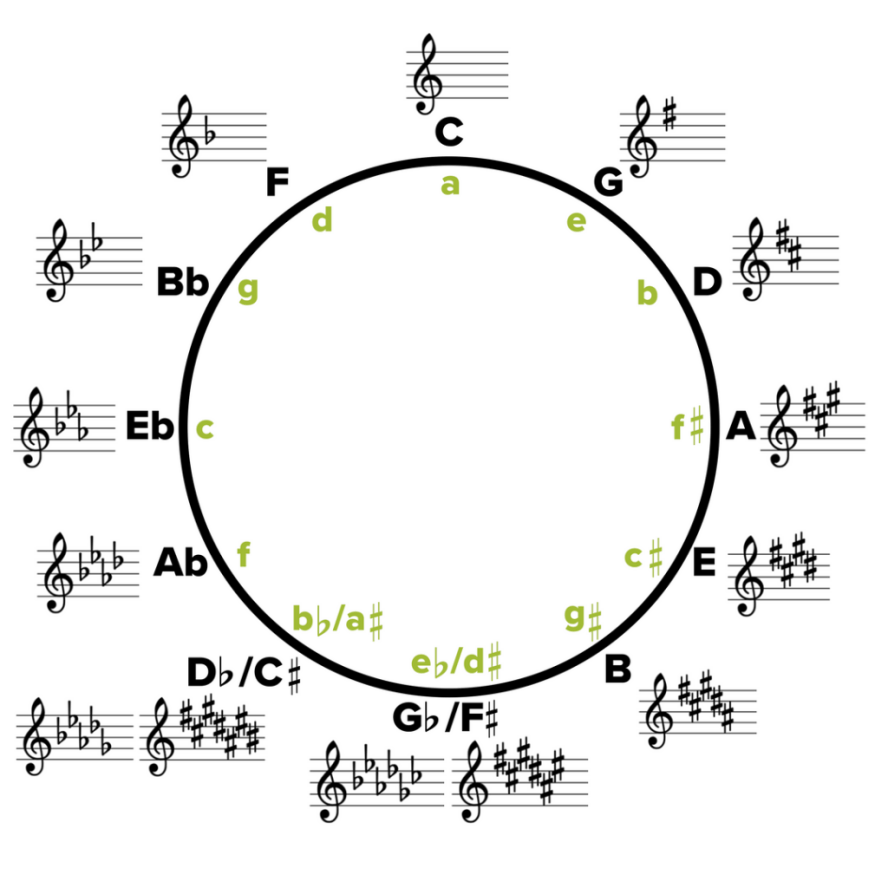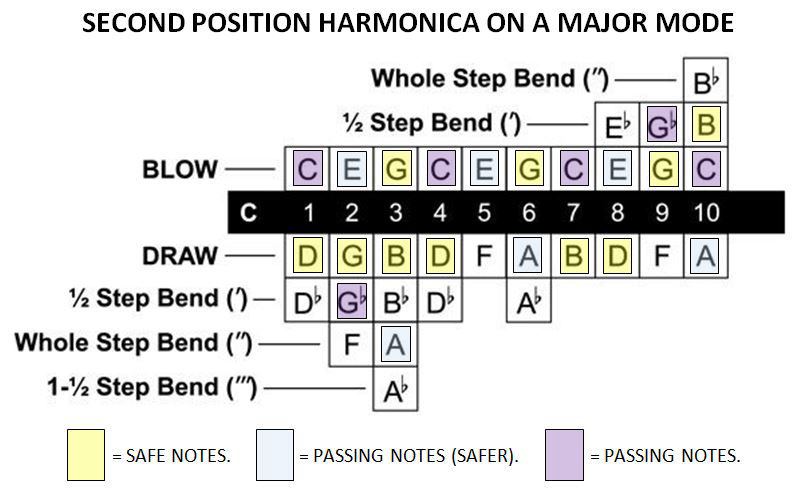
Today I will teach you everything you need to know, in order to play in 2nd position with your harp. If it's been quite a while ago since you set foot into the world of harmonica as a newbie, then it won't be surprising if, by now, you are already acquainted with some commonly used terms like the first position or the second position, and may even have heard about the third position also and so on. So what should one comprehend by the phrase, 'to play in the second position' also referred to as Cross Harp? Following this lesson would yield in knowing answers to all such queries, and you can find a second position online course here.
Let's look at the circle of the fifth; the second position can be identified as the one lying immediately before the key of the song when scrolling the circle counterclockwise.
For example: if we take a C harp then we can play in second position on a G tune.The same would be the case if we take an A harmonica; i.e. we can play the second position on an E track, and this is a typical case for blues due to the reason that it's played, as much as around 90% of the times, in cross harp.

After selecting both; i.e. harmonica and the position in which to play, the next step is to explore the instrument to understand which notes it makes available - useful for playing in the chosen tonality - which ones are absent and which notes must be avoided because they are not part of the key in question. To conduct this analysis, we have to keep in mind that the same position can be played in different musical contexts; e.g. the song can be major, minor, or blues. The evaluation of the notes present on the harmonica must be done for all these three situations.
After you have chosen the harmonica and the position to play wherein, both, you are all set to examine the instrument thoroughly so as to discover the specific notes, it renders available to you, which are deemed most suitable for playing in that particular key, not to mention those notes alos which you'll find lacking altogether.
In addition to the above two categories you must also be cautious about the ones which you must avoid playing at all cost because they aren't a part of the tonality. While conducting this analysis, one should keep this in mind, that the same position can be played in different musical contexts, owing to the feature that a song can be either major or minor or possibly blues type. Furthermore - as we are also very conscious about the type of performance we'll get in return - it should be noted that even though a position offers useful notes to perform melodies, one should not ignore that the same notes, might not be appropriate for playing chords. We will discuss this in detail in another lesson.
Let's start analyzing all aspects one by one, while exploring harmonica in second position on a major song. "What characterizes a major tune?" The answer won't be other than: the third interval of its reference scale. In case of a major G key, the third is, B. If this note is natural, the track would be major, if it happens to be flat, the track will turn out to be in minor tuning. "What about the blues mode then?" Let's denote it as a combination lying between major and minor, as on the blues we can play both the third major and the one half a tone below; this minor third is called 'blue note' and that's what characterizes this musical genre.
Let's go back to the major tonality and the harmonica in the second position.
We take a C harp and play in the second position on a G song. If the song lies in G major, its reference musical scale will consist of the following notes: G, A, B, C, D, E, F#.
Not all the notes of this scale are present on a C diatonic harmonica; in fact, we can play the F sharp only with the bending technique: on holes 2 draw and 9 blow. Don't worry! You can try playing some other notes.
One can observe the hierarchy which exists among the notes of the scale and if we can manipulate this, we will always be able to foresee which notes to use and why? You should understand that each note has a function in connection with the scale of reference, but it also has a purpose in accordance with the chord presented by the 'chord sequence of the song'. The same note has different connotations depending quite much on the moment.
The most important note while playing in second position is the one that assigns the name to the key; e.g. in case of G major, it's the G note. Let us assume this note as grade 1, so that even when we alter the key, reasoning remains unchanged. To study these concepts, I always refer to the notes first which are emitted by a C instrument, then it's the job of harmonica to transpose the notes for us when we change the key. The G note is located on holes 2 draw, 3 blow, 6 and 9 blows. When we play these holes we will always be tuned to the song.
The second important note to play in second position is B: third degree; although we already recognize this as the one that determines the mode of the song. Since we are on a major track, the harmonica makes this note available on holes 3 and 7 draw, and 10 blows with 1 half-tone bending. This note is quite challenging to play with precision.
The third note to play in the second position is D: fifth degree and we can find it on the holes 1, 4 and 8 draw. These are the important notes because they form the G major chord.
We continue now with the other notes:
The A note, or second interval sounds pleasant everywhere in the major G key and we pin point this on the 3 draw hole with double bending, 6 and 10 draw. We can also make use of this note as a passing note.
The note C - an interval of a fourth - should only be used as a passing note because with the perspective of harmonic progression of the piece, it might sound a little 'out of' theme'. We may find this note on holes l, 4, 7 and 10 blow.
The E note or sixth interval can be played leisurely and has absolutely no contraindications. You may get this on holes 2, 5 and 8 blow.
The last note we consider is F#. This note, also known as 'sensitive', is a peculiar one and is best used when played as a passing note. As I informed you in the beginning of the article, we may find this note with bending only and on holes 2 and 9.
To make it even simpler for you to learn the second position with the harmonica; I will show you the notes layout of the instrument upon which, hierarchy of the notes to play, is based .

We now perform the same evaluation for a minor track:
Alongside the minor key; there are several other reference scales to consider. The important thing, however, is that the third must be played one step lower; e.g. in case of G, the B becomes flat. This scale is named as 'Dorian' and it contains: G, A, Bb, C, D, E, F. In this scale, grade 3 becomes minor (Bb) as well as grade 7 (F). Where do we get these notes on the harp?
Till now, we have clearly figured out where to find all the notes except B flat and F. The flat B can be located on holes 3 draw by bending of a half-tone and on hole 10 blow with whole- tone bending. The F is to be found on hole 2 draw with bending of a whole tone and also on holes 5 and 8 draw.
In short, we can play a minor song in the second position of the harmonica without much difficulty. Nevertheless, if we do not possess a good hold over the instrument, we may end up restricting line of action for us.
Let's evaluate harmonica notes to play the blues in the second position. The G blues scale consists of the following notes: G, Bb, C, C#, D, F.
In addition to the notes we are already familiar with, we may find the C sharp as a half-tone bending on holes l and 4 draw. So it appears that on holes 2 to 5, we can play a full G blues scale which is not possible on the rest of the instrument otherwise; where we do have the oppotunity to exploit other musical scales also.
C and C# notes should be played as passing notes.
It should be made explicitly clear with respect to the F note that when the blues progression comes on the fifth degree chord ( as in the case of a G blues, it's the D7 chord) we are free to play the F sharp note owing to the reason that it's the third degree of the chord in question. This note, however, should not suppress the rest of the blues progression in second position. For this position, we can also use the G pentatonic scale notes, which are G, A, B, D, E. The notes A and E are meant to be played as passing notes.
You'll notice that now l'm talking about the natural B note: the blues in particular; as it allows the coexistence of both major and minor thirds, which isn't possible otherwise in the major and minor tracks, where it is the third that determines the key mode. Be mindful, B natural should not be played when the blues progression moves onto the fourth chord: in the case of a G blues, it's the C7 chord. The seventh minor of C is, in fact, a flat B and it doesn't go together with a natural B.
Let's review how second position can be used:
Second position harmonica on major tunes: Really beneficial.
Second position harmonica on minor tunes: Useful - with some limitations.
Second position harmonica on blues tunes: Highly recommanded.
I would sum up this article by inviting you to explore other positions too as by now you must have reached the conclusion: notes exploration; in a way to satisfy the probability of finding more notes on the harp, is the best way to excel it. Keep Harpin'!
If you want to comment this lesson use the contact form available here.
Robert Milo
Thanks you for this lesson. I like the way you analyze every concept in your teaching material. I've been following you for a while now and I will continue to visit your website. I play for the most in 2nd position but I want to learn more about 3rd and 1st position.
Jin Lee Owen
Sir, this lesson helped me a lot. I bought my first harmonica three weeks ago and I'm learning now about positions playing. Second position is the first thing I want to practise. Thanks again for these clear explanations.
Alicia Gonzales
Hi there! Im a really new harmonica player. I have a D harmonica, I understand I can play it on an A song in second position, is it right? Do you suggest me to buy a C harmonica? Maybe it would help more in learning these theoretical concepts? Thank you for the lesson.